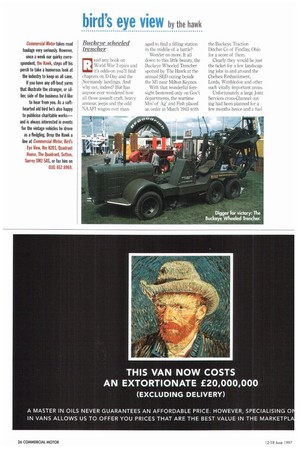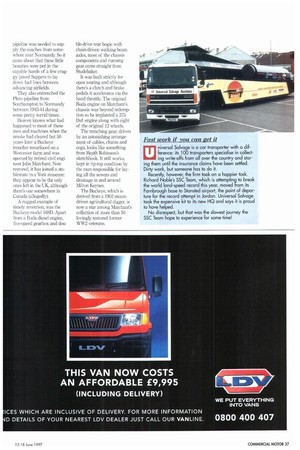bird's eye view by the hawk
Page 28

Page 29

If you've noticed an error in this article please click here to report it so we can fix it.
Buckeye wheeled trencher
cad any book on World War 2 epics and it's odds-on you'll find chapters on D-Day and the Normandy landings. And why not, indeed? But has anyone ever wondered how all those assault craft, heavy armour, jeeps and the odd NAAFI wagon ever man aged to find a filling station in the middle of a battle?
Wonder no more. It all down to this little beauty, the Buckeye Wheeled Trencher spotted by The Hawk at the annual SED outing beside the M1 near Milton Keynes.
With that wonderful foresight bestowed only on Gov't departments, the wartime Min' of Ag' and Fish placed an order in March 1943 with the Buckeye Traction Ditcher Co of Findlay, Ohio for a score of them.
Clearly they would be just the ticket for a few landscaping jobs in and around the Chelsea Embankment, Lords, Wimbledon and other such vitally important areas.
Unfortunately a large Joint Services cross-Channel outing had been planned for a few months hence and a fuel pipeline was needed to supply the coaches from somewhere near Normandy. So it came about that these little beauties were put in the capable hands of a few craggy jawed Sappers to lay down fuel lines between advancing airfields.
They also entrenched the Pluto pipeline from Southampton to Normandy between 1943-44 during some pretty torrid times.
I leaven knows what had happened to most of these men and machines when the smoke had cleared but 50 years later a Buckeye trencher resurfaced on a Worcester farm and was spotted by retired civil engineer John Marchant. Now restored, it has joined a stablemate in a York museum: they appear to be the only ones left in the UK, although there's one somewhere in Canada (allegedly).
A rugged example of timely invention, was the Buckeye model 16SD. Apart from a Buda diesel engine, five-speed gearbox and dou
ble-drive rear bogie with chain-driven walking-beam axles, most of the chassis components and running gear came straight from Studebaker.
It was built strictly for open touring and although there's a clutch and brake pedals it accelerates via the hand throttle. The original Buda engine on Marchant's chassis was beyond redemption so he implanted a 375 Daf engine along with eight of the original 12 wheels.
The trenching gear, driven by an astonishing arrangement of cables, chains and cogs, looks like something from Beath Robinson's sketchbook. It still works, kept in tip-top condition by the man responsible for laying all the sewers and drainage in and around Milton Keynes.
The Buckeye, which is derived from a 1902 steamdriven agricultural digger, is now a star among Marchant's collection of more than 50 lovingly restored former WW2 veterans.
























































































































